Rand Fishkin shocked us all on November 13 onstage at SMX East in NYC.
I heard audible gasps at some slides – the anxiety climbing up our throats as he made his undeniable argument.
Google is no longer “everyone’s search engine,” Fishkin asserted.
They’re now “everyone’s competitor.”

Google. One of the most powerful tech companies in the world. One we depend on for traffic, revenue, and leads.
Competing with us little search marketers.
It used to be a give-and-take. We provide the content – Google provides the traffic.
But for the first time in history, that relationship has become lopsided, favoring Google. For the first time in history, more searches end on Google – without a click – than with one.
These are the so-called “zero-click searches.” Already, more than 50% of Google searches end without a click.
And that’s a huge threat to our websites.

Even more, this has been a silent threat, since – in SEO – we tend to measure success in terms of rankings and “visibility.”
But all the rankings and visibility in the world are meaningless. If the Google searcher never actually lands on your page, what’s the point?
The reason to build a website is for customers to visit it. And as of now, half the time that just isn’t happening.
Why Is Google Zero-Clicking Our Websites to Death?
A cynic might argue that this is all about money. After all, Google already has a 90% market share of worldwide search engine traffic.
How else can they increase revenue to satisfy their shareholders?
There’s not much room for larger market share, so they are forced to better monetize the traffic they have.
But that’s not the whole picture. Despite dropping “Don’t be evil” from their company motto in 2015, they’re still good people (and “don’t be evil” is still part of their company code of conduct).
They’re just serving their customers as best they can. And in SEO, business and their websites – as well as us digital marketers – are not Google’s customers. Searchers are Google’s customers.
Google wants to create the best possible user experience for the searcher. And if that means scraping lots of websites and putting the answer right on the search engine results page (SERP) – they’ll do that.
When I search for song lyrics and they handily pop up – in their entirety – in the Google search results, saving me a click, I’m grateful.
But lyrics sites like genius.com aren’t happy (to the tune of a $50 million lawsuit against Google) because they are being deprived of traffic they rightfully feel they deserve.

Genius provided the content. Google is supposed to reward them with traffic. But no. They prioritize the needs of the searcher over the needs of the website.
Already, more than 50% of Google searches end without a click. And that’s a huge threat to our websites… [A]ll the rankings and visibility in the world are meaningless. If the Google searcher never actually lands on your page, what’s the point?
What Are Websites Missing out on From Zero-Click Searches?
Here’s what we’re missing out on in the 50% of searches that end with zero clicks to our website:
- List building.
- Retargeting.
- Brand equity.
- Revenue.
All of that value goes to Google instead.
And it’s happening in every niche. Take Rand’s example from SocialMediaExaminer.com. SME ranks #3 in the world for the search term “social media.” That ranking gets them 1.43 million impressions per quarter. But just 11,800 clicks.
That CTR is tiny: just 0.8%.

So why does SEO superstar Brian Dean estimate that position #3 should be getting 18.66% of the clicks?
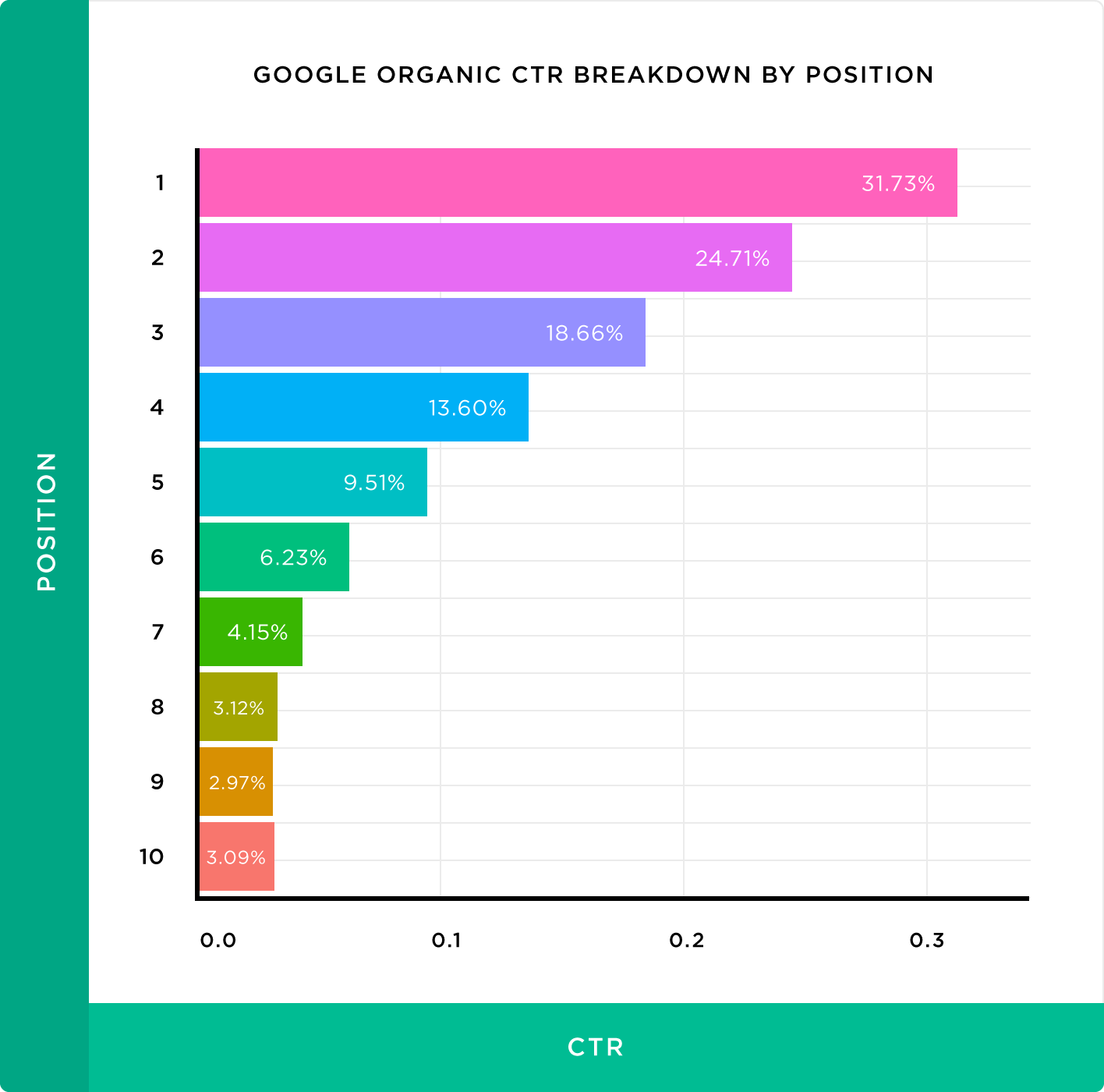
The reason is that not all SERPs are the same. Some SERPs are crowded with competition from Google – especially stuff that appears above the organic links:
- Ads.
- Knowledge Panels.
- Answer Boxes.
- Featured Snippets.
Those searches get low CTR for SEO – so we don’t target them.
We want traffic, not just visibility.
The SERP for “social media” perfectly demonstrates this problem. Above the fold on the SERP, 33 out of the first 37 links (89%) lead straight back to google.com:
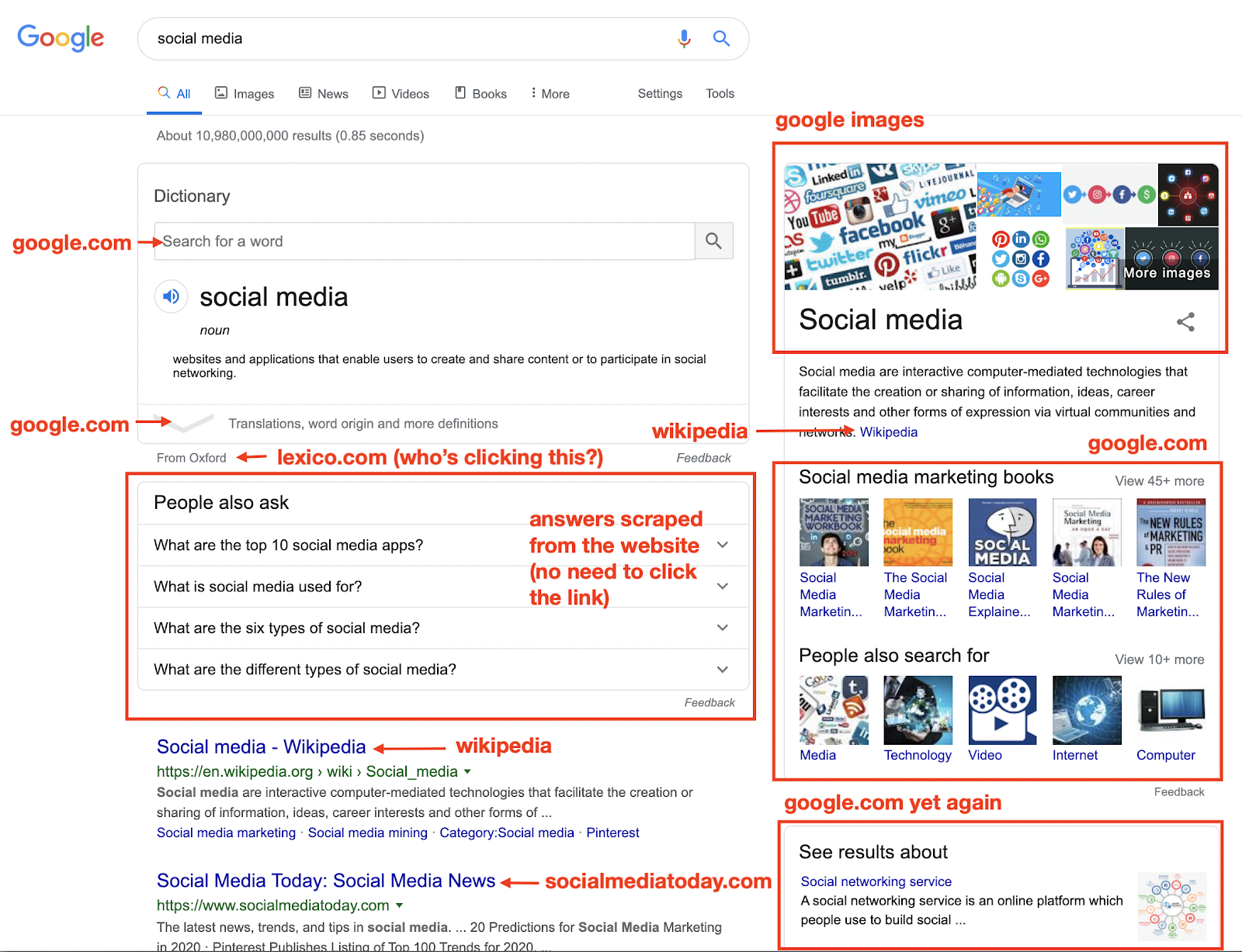
With all those distractions, no wonder SocialMediaExaminer.com gets so little traffic.
And this problem extends to every niche.
Proof That the Google Zero-Clickpocalypse Is a Growing Pandemic
Let’s look at some niches affected by the “zero-clickpocalypse.”
Products
Google is extremely worried about losing further market share for product searches to Amazon (the majority of product searches in the U.S. now start on Amazon, not Google.)
As a result, Google is working to provide the Amazon experience for shopping.
This is bad news for ecommerce websites. If Google continues in this direction, it threatens to turn your website into a mere supplier for Google.
There are a few reasons for this.
First, Google lists your products alongside the same products from other websites – and the price.
This leads consumers to choose the site with the cheapest offer. Ecommerce sites in this situation can compete on only one dimension – price.
This starts in the Shopping widget – here’s the result in the U.S. for “54 inch curved screen tv”:
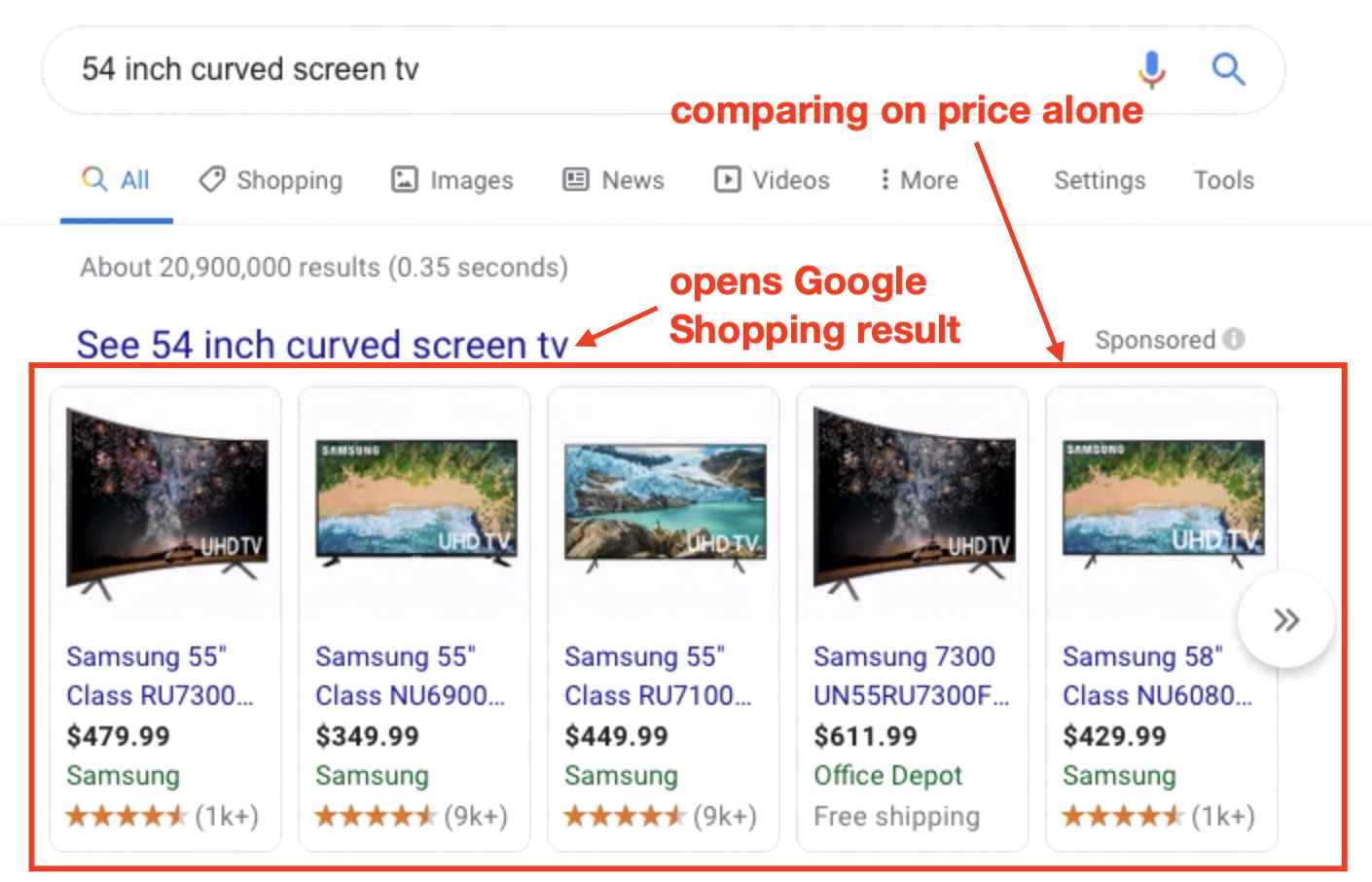
This experience continues when the searcher clicks the “See 54 inch curved screen tv” link and opens Google Shopping.
Office Depot – the first result – either pays for a click from their Google Shopping Ad or the searcher clicks a link to “Compare prices from 20+ stores”:
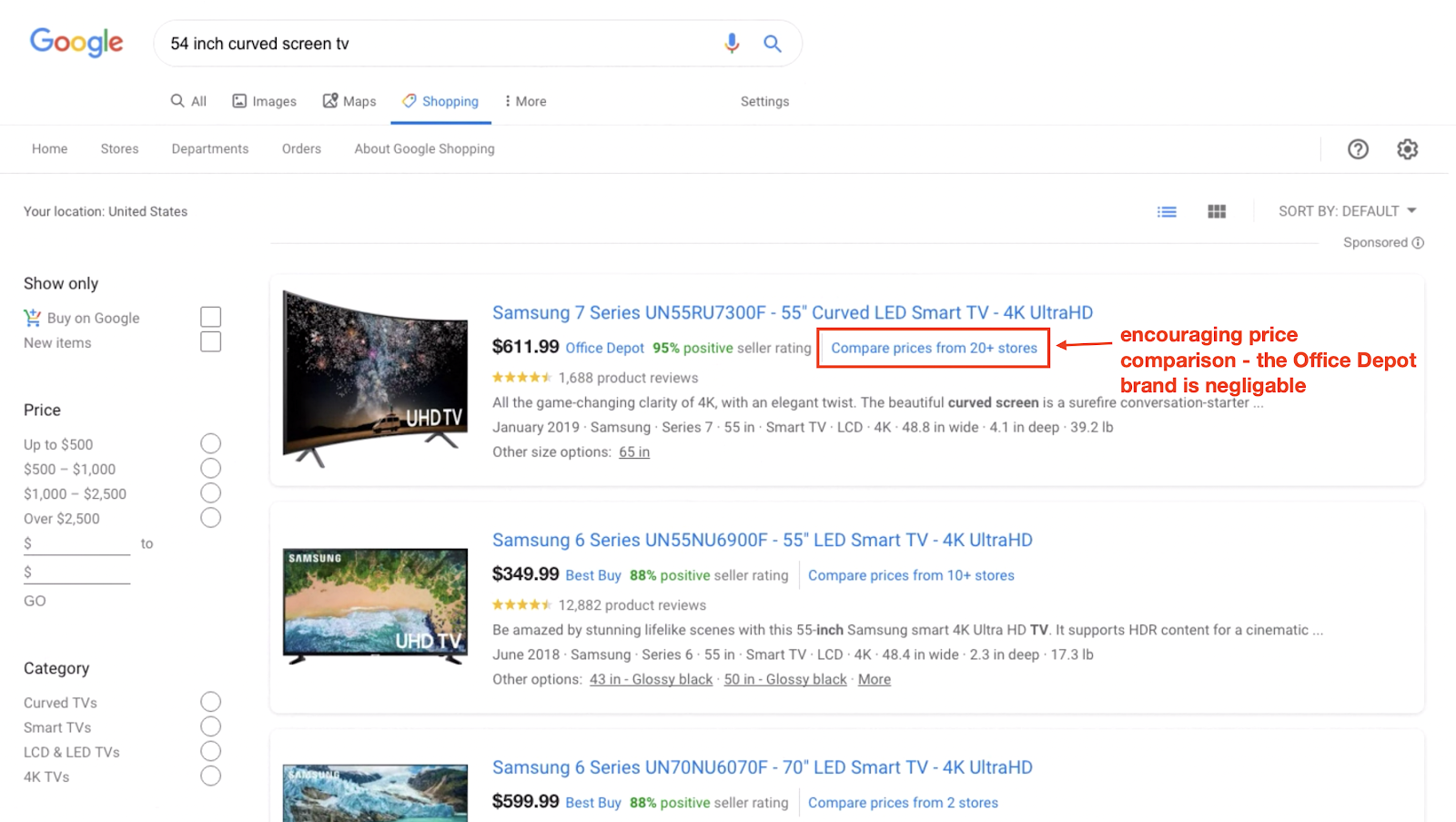
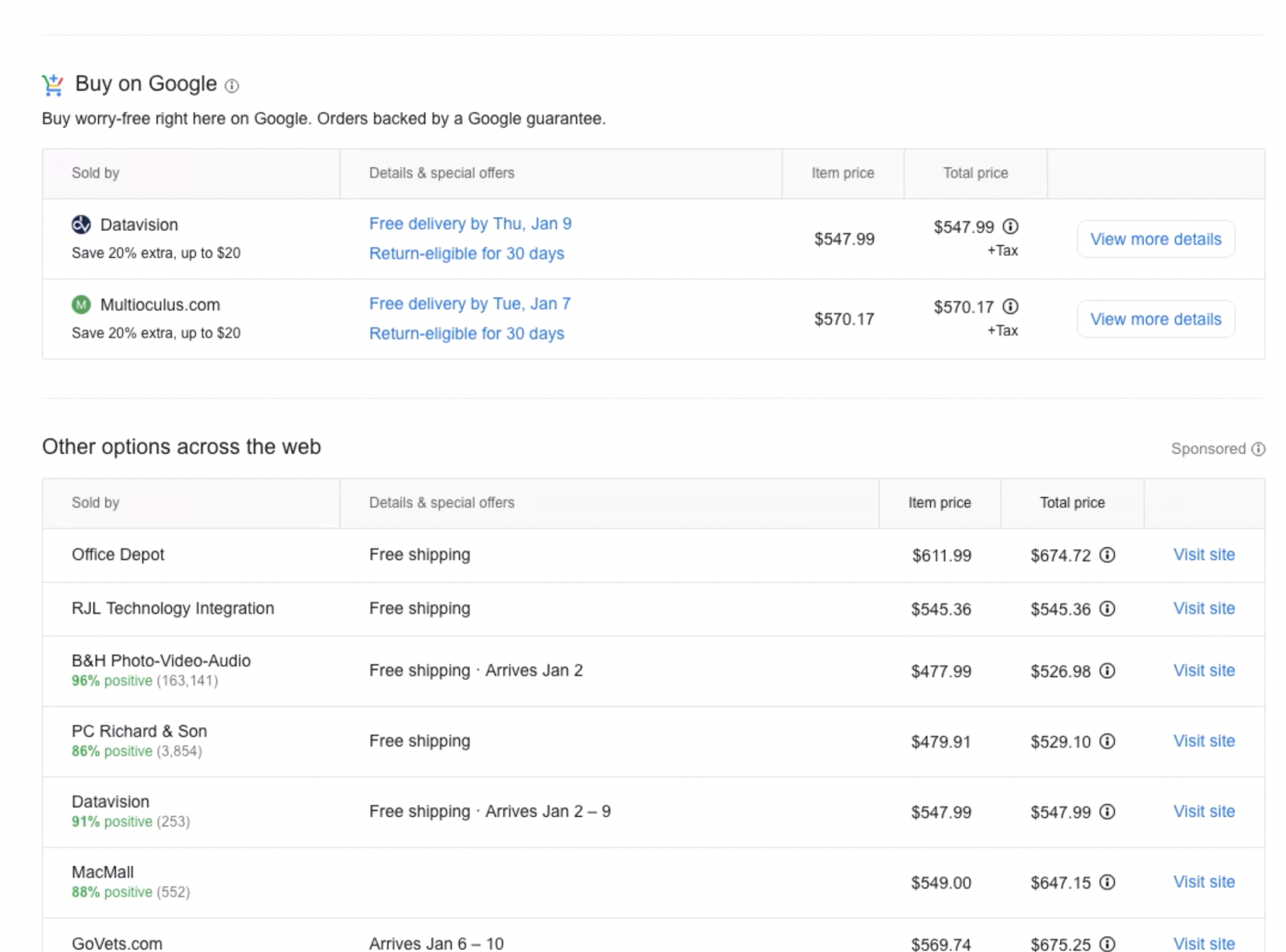
Once here, there’s no differentiation from one ecommerce website to the other. The 55-inch curved tv has been commoditized. Datavision or Multioculus.com wins the sale, but only because of heavy discounting.
In ecommerce, that might normally be a shrewd decision – but only if you can get repeat sales from the same customer. In the world of Google Shopping, however, Google handles the payment too.
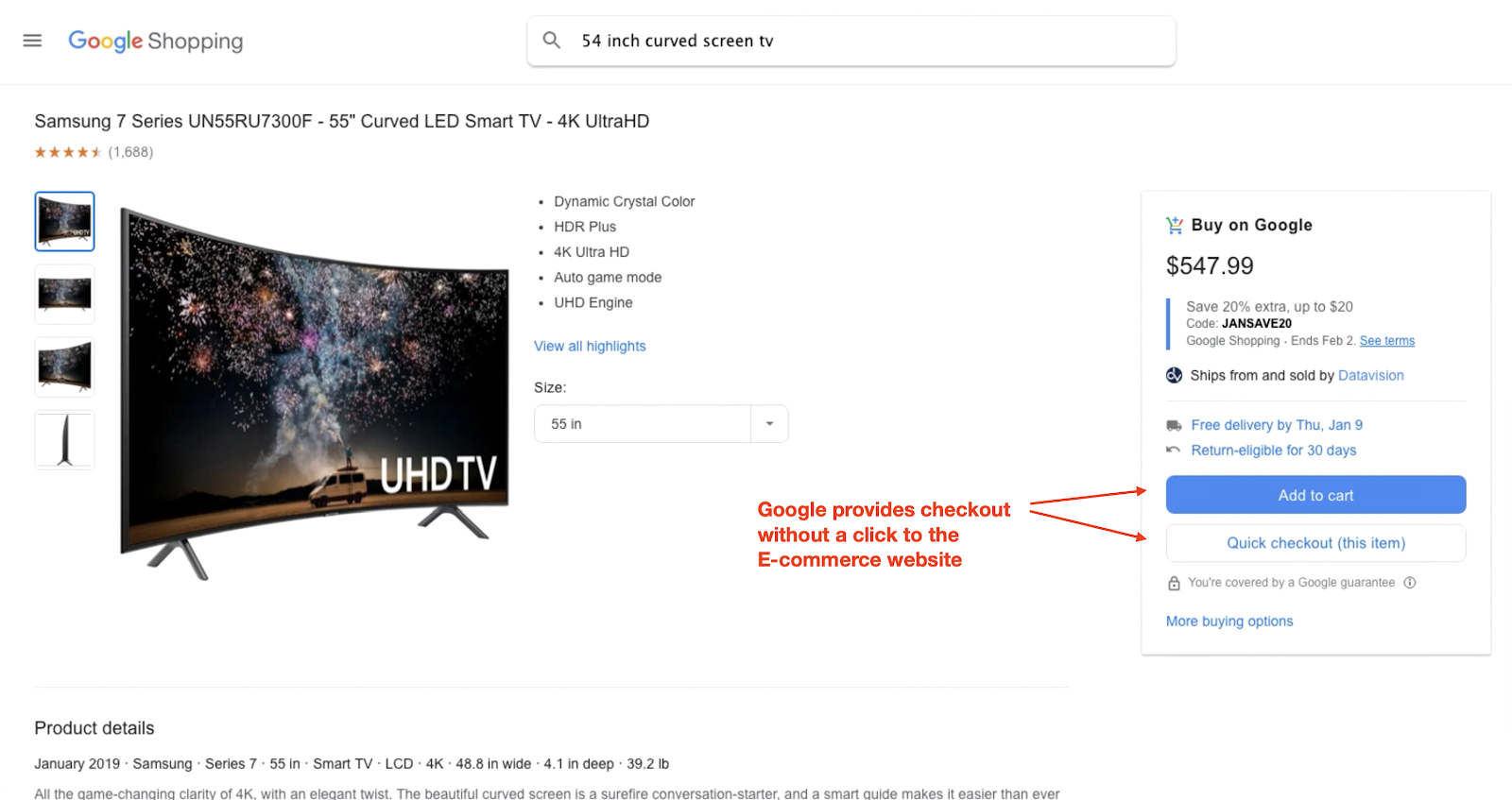
There’s no need for the searcher to ever land on your website.
Gone is your traffic, your margins (after heavy discounts to win the sale with the lowest price), your brand equity (the searcher doesn’t need to pay attention to your brand – as Google states, “You’re covered by a Google guarantee”), and your opportunity to do retargeting and remarketing with this buyer.
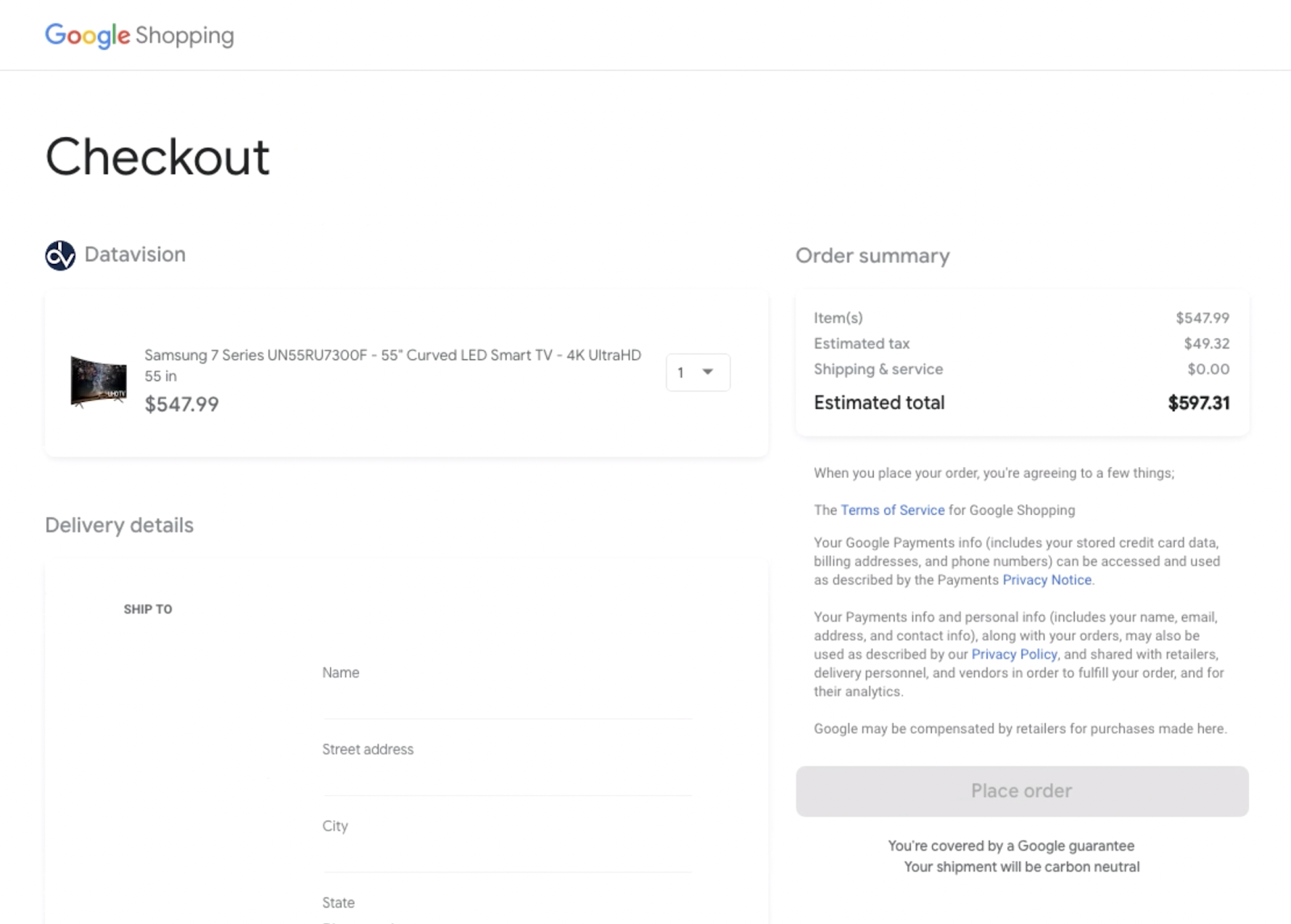
This is why we say that Google is threatening to turn ecommerce websites into mere suppliers with zero-click searches.
Hotels
The hotels niche has millions of longtail keywords that seem good for SEO, but aren’t – because they end up as Zero-Click searches. Take one example: “pet friendly hotels las vegas.”
On the surface, it seems like a really nice longtail search – and in the past, we would have recommended a customer in the hotel niche to include it in their list of Longtail UX pages.
Not anymore.
Ads, Featured Snippets, and Answer Boxes push the organic results for Hotels.com and Expedia far below the fold. This robs them of most of their organic traffic:

So why optimize for it?
Optimizing for an Answer Box is not a good solution either. Because the searcher gets the entire answer right on the SERP without having to click on the link to TripSavvy.com:
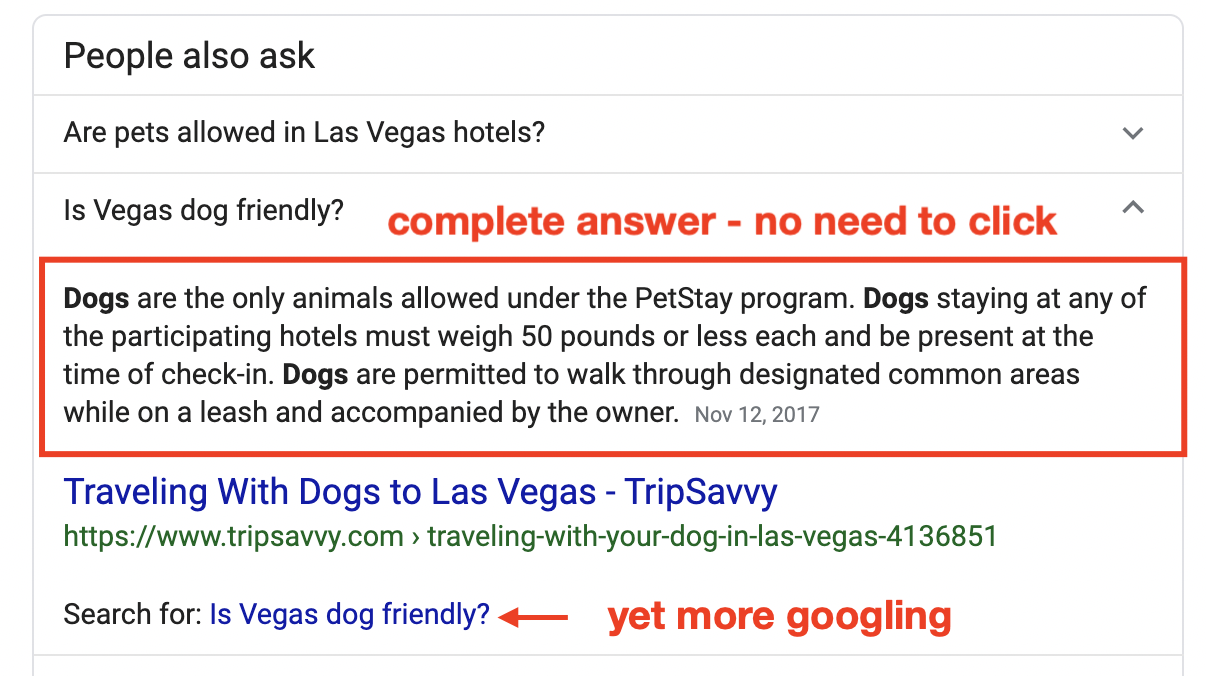
Flights
Kayak and Skyscanner are in trouble. Because Google’s Rich Snippets are gobbling up real estate on all the SERPs that used to bring them flight comparison shoppers:

Again, ranking for these Answer Boxes is pointless.
If the searcher wonders “How long is the flight from Australia to New York?” she expands the box and finds the answer: 21 hours.
TravelMath.com misses out on traffic, revenue, and everything else.
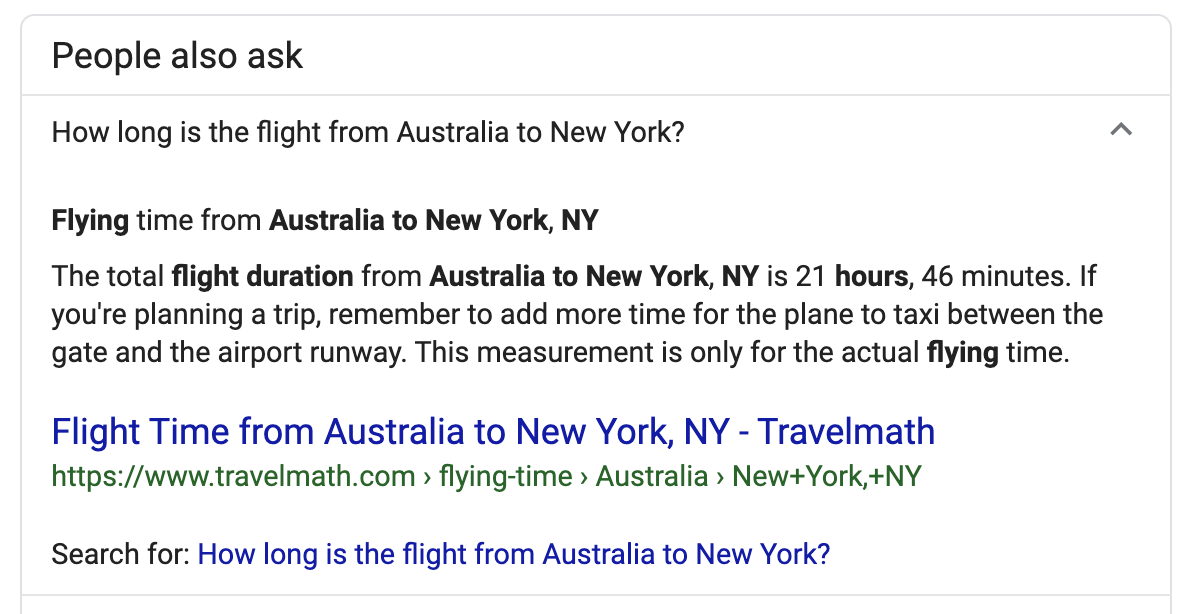
Jobs
Google now directs 38% of job searches to the Google Jobs widget and ads:


There are many other niches where zero-click searches are scraping their content, siphoning their traffic, and crushing their business model.
Movie reviews, weather, dictionary and thesaurus, currency conversion, world clock, and many others. It truly is an epidemic, and Google’s latest algorithm update, BERT – its biggest in 5 years – will only accelerate this trend.
Google’s BERT Algorithm Will Likely Increase Zero-Click Searches
BERT, Google’s algorithm update from November, will increase the number of zero-click searches because it focuses on answering specific longtail searches like the examples above.
Google has already confirmed it will use BERT to increase the number of featured snippets in 25 different languages.
And we’ve already identified that more featured snippets means more organic search results pushed further below the fold.
In other words… more zero-click searches, more traffic for google.com, and less traffic for our websites.

The impact on websites from BERT is, and will be, huge. SEO master Barry Schwartz hypothesizes that the reason the SEO community hasn’t noticed much of an effect is that the search terms BERT impacts are longtail.
“Tracking tools,” wrote Schwartz, “such as Mozcast and others, primarily track shorter queries. That means BERT’s impact is less likely to be visible to these tools.”
Schwartz echoes what I’ve said above – that SEOs focus on rankings and visibility. This is a risky move when many of those searches will never deliver traffic to your website.
The answer to this zero-clickpocalypse is to put the focus back on traffic, revenue, and leads – for both SEO and SEM.
This final section will show you how to do that – and a new tool you can use for free that will tell you how much revenue you can reclaim.
Getting Zero-Click Traffic Back From Google in SEO
Fishkin gave a few solutions to websites facing zero-click searches, but they were more long-term (for example, reporting Google to the media, like genius.com did.)
We’d like to share some solutions you can implement today – for both SEO and SEM.
In SEO, the solution to the zero-click search problem is a three-step one:
- Track the right SEO metrics.
- Find your longtail keywords.
- Target rich longtail searches.
Track the Right SEO Metrics
Forget about rankings and visibility. As shown above, with Product, Hotel, Flight, Jobs, and many other searches, tracking your website’s presence on the SERPs is an extremely unreliable metric for success.
What to report on: traffic, revenue, and leads.
Moreover, we should be reporting on our SEO ability to bring in new customers – which means separating out customers acquired from non-brand searches (keywords not containing your website brand name.)
We’ve outlined the method to do just that – manually – here by using your search terms in Google Analytics.
It’s a lengthy process, so I recommend you instead take an easy shortcut – run our Search Scorecard for free. You’ll get a full report in under two minutes.
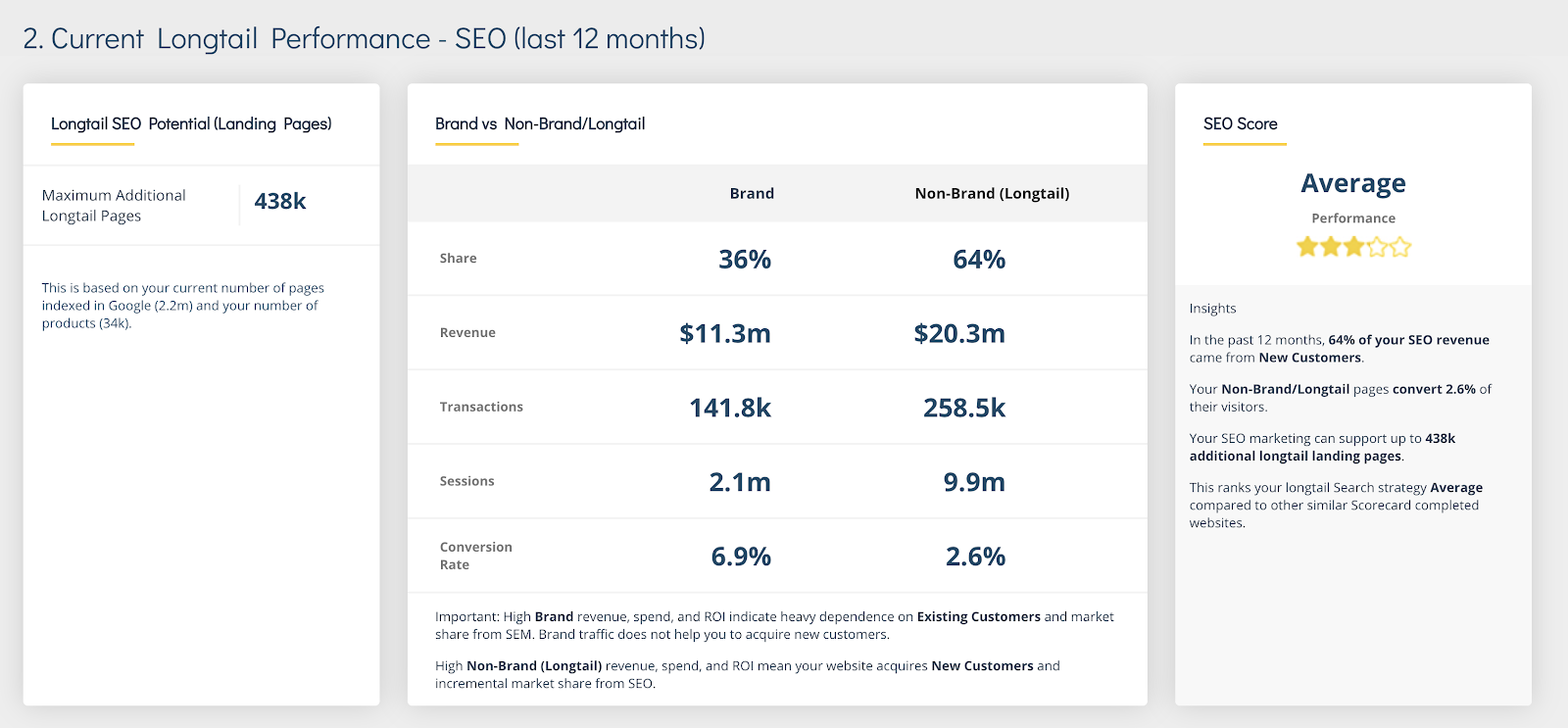
In the Scorecard report above (run by an ecommerce website using their Google Analytics search terms), you can see that more than 60% of their SEO revenue comes from new customers who search for non-brand search terms.
That’s a pretty good rate – their SEO is designed to bring new customers to their website, not just relying on searches for the website’s Brand name.
Often, we see brand Search Terms making up 80% or more of SEO revenue – which means a ton of revenue is being lost to competitors in their niche.
Find Your Longtail Keywords
Like we saw above, ranking well for even a competitive, highly searched head term like “social media” can bring little actual value to a website (with sub-1% clickthrough rates from the SERP even when ranking #3 globally.)
Fishkin reported that the dictionary website, m-w.com (Merriam Webster), lost 30-70% of their available clicks when Google expanded Definition Boxes in its SERPs.
Targeting longtail search terms (in particular, 4 words or more) is a step in the right direction. It’s the foundation for an SEO strategy that avoids Zero-Click Search losses to Google and other competitors.
However, the longtail searches you target must represent a competitive advantage you have in your industry – something specific you do remarkably well.
When the searcher sees that you specialize in a unique type of product or service they’ve been searching high and low for, you’ll win an ecstatic new customer who will reward you with high conversion rates and lots of repeat purchases.
We help our customers find these longtail searches with a lot of special sauce – but the first place we look is in their Google Ads paid search terms.
This contains a treasure trove of longtail keywords that demand their own, specific landing page. Searchers want them. That landing page just doesn’t exist on your website – yet. (Which is why marketers use Longtail UX to create them.)
We include the Top 100 longtail pages you should be building first in our free Search Scorecard:

This tells you which landing page URL you’re currently using to answer that search term.
Once you build the longtail landing page to serve that specific search query (either by yourself or with Longtail UX), you should link to the new page from the URL in the “Linking Page” column.
That’s usually enough link authority to rank it well.
Target Rich Longtail Searches
Don’t target search queries that can be answered in a sentence or two. “Weather in oxford michigan,” “parasite movie box office,” “time in new york,” “100 usd to canadian dollars.”
Target rich searches that require deep information – like ever-changing prices, pictures, reviews, and nuanced information about your products and services.
These types of searches are zero-click-proof.
For example, one Longtail UX customer, Kogan.com, found with us that they should be creating landing pages for electronics with highly specific, desirable attributes for informed buyers. Here’s one – “cheap 55 inch smart tv”:
The answer box below their organic result won’t poach traffic, because searchers want to see exactly what Kogan promises to deliver – the “top 5 products for cheap 55 inch smart tv.”
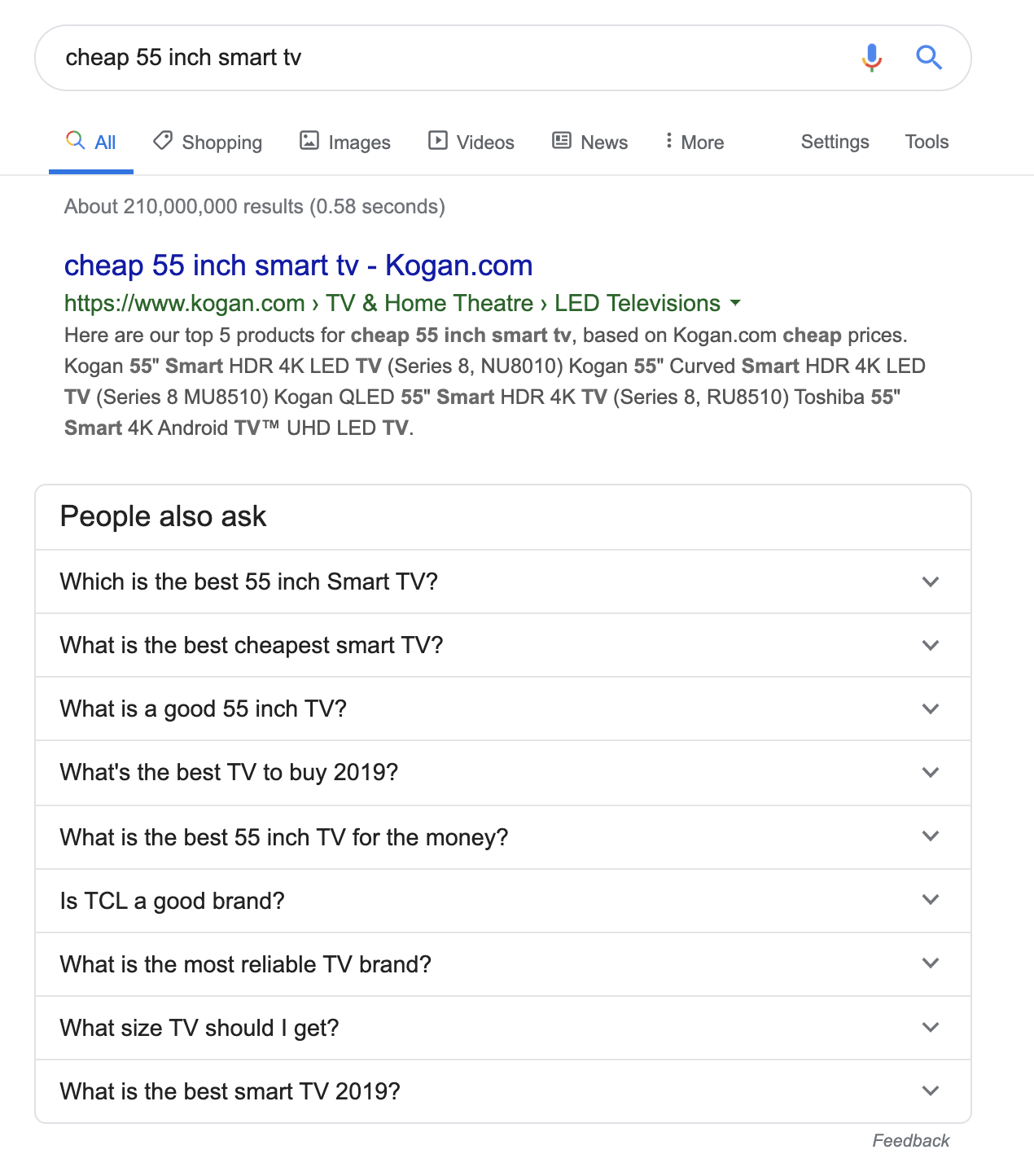
Those answer boxes also won’t show all the photos, prices, reviews, and specs that searchers want to see while informing their decision to buy.
The same applies to competitors trying to knock Kogan out of the game for this search. None of them creates the remarkable experience a customer typing this exact query into Google is looking for. In each case, some attribute they wanted is missing:

Kogan has ring-fenced this longtail search query. They own it.
Moreover, they’ve created more than 35,000 such pages with Longtail UX – and generate millions of dollars in revenue from them each year.
You may be able to do the same for your website – and you can find out now whether it’s possible.
The Longtail UX Search Scorecard also contains a “Revenue Opportunity” section that estimates your website’s potential for acquiring new customers.

You can run it for free now here to see yours.
Bonus: The Last Guaranteed Way to Get Search Traffic to Your Website
Those of you in SEM may find this bonus section a bit shocking.
Because the last guaranteed way to get search traffic to your website…
…is good old-fashioned text ads.
Seems almost everyone has forgotten about them. In retail, 80% of paid search today goes to Shopping ads. That makes sense.
Shopping ads are easy to set up – connect your product feed to Google and press go.
But in the long run, Shopping ads will cost you twice as much to acquire a customer as text ads leading to a longtail landing page.
This is because Shopping ads land the searcher on a product detail page – a single product landing page. Websites pay twice as much to get a sale on a product detail page as pages with multiple product offerings.
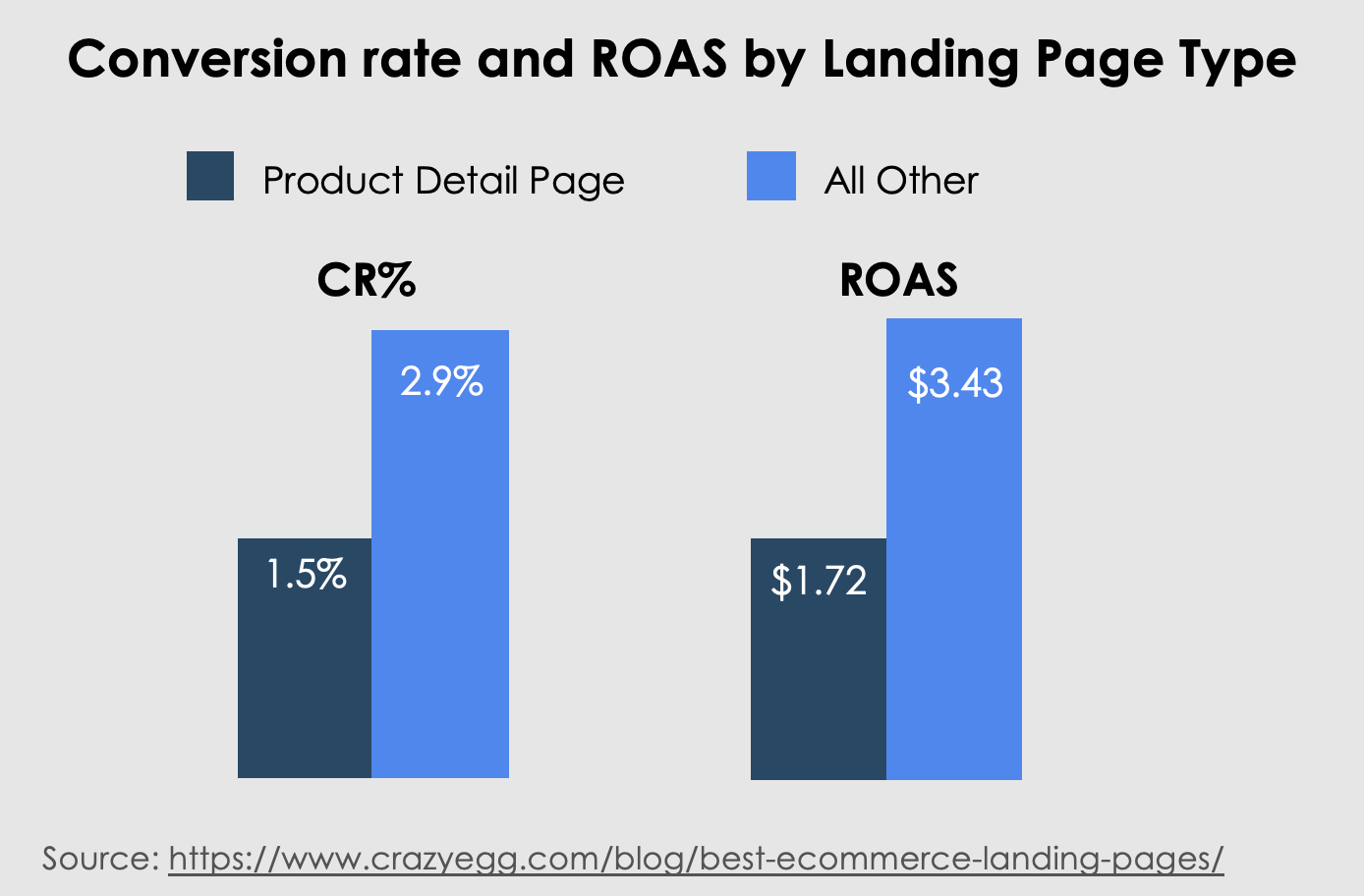
Consider the difference between these two search experiences, for the longtail search “frizzy hair shampoo.”
In the first, we have the Google Shopping results. Clicking any of these results opens a new tab with a single shampoo product:

For example. Click on the first Paid Shopping result from Bondi Boost – Google opens a new tab.

Why a new tab?
Because Google knows the searcher will need to return to the Shopping widget on their SERP to click lots of these results before finding the exact product they want.
We call this “pogo-sticking,” because the searcher has to go back and forth between these tabs, hunting for a good product.
Now look at the experience a searcher gets when she lands on a longtail page AdoreBeauty created with Longtail UX:

With 18 products to choose from, AdoreBeauty doubles its conversion rate and cuts its customer acquisition cost from Paid Search in half.
And they’ve done this with more than 2,500 landing pages.
Also, to make sure only searchers with the exact intent to buy specifically “frizzy hair shampoo,” AdoreBeauty use only spend SEM budget with single keyword ad groups (SKAGs).
This ensures that visitors won’t arrive on this page for any other purpose than to buy exactly this type of product.
The reason not everyone does this is simple: effort.
Running text ads manually with changing inventory and pricing is a nightmare. That’s why they automate paid ad creation and management using Longtail UX.
This is another area you can estimate with the Longtail UX Search Scorecard. Along with the potential for reclaiming market share lost to Google and other competitors using SEM, it will show you your SEM Score.
This lets you evaluate what percentage of your search budget goes to exact match terms (good), and how much return on ad spend (ROAS) you get from new customers in search.

To run the Search Scorecard for free in under two minutes, go here.
Find out how much value in traffic, revenue, and leads you can reclaim from Google and other competitors in Search.
The opinions expressed in this article are the sponsor's own.



